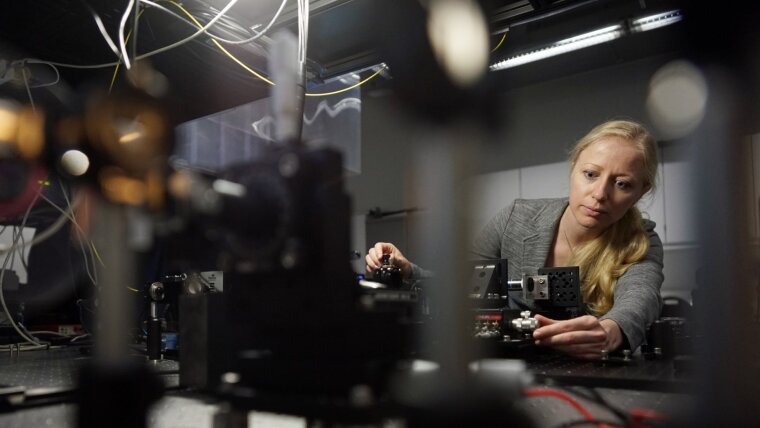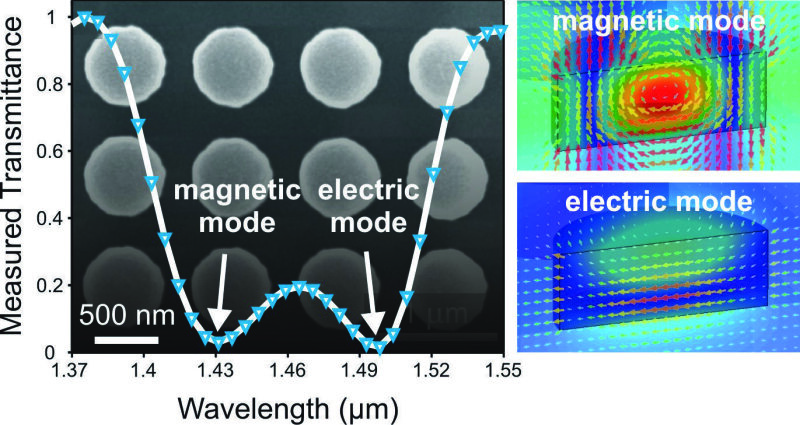
Prof. Isabelle Staude.
Image: Anne Günther (University of Jena)Prof. Dr. Isabelle STAUDE
Email: isabelle.staude@uni-jena.de
Phone: + 49 3641 9 47330
Prof. Dr. Isabelle Staude joined the Abbe Center of Photonics in July of 2015. Initially, she established a junior research group on functional photonic nanostructures, before becoming a professor for photonic nanomaterials in April 2020. She is an elected member of the Faculty Council of the Faculty of Physics and Astronomy at the Friedrich Schiller University Jena, a member of the German Young Academy, and a member of the Management Board of the Collaborative Research Center (SFB) "Nonlinear Optics Down to Atomic Scales" (NOA).
The Photonic Nanomaterials Group is primarily dedicated to the study of the fundamental optical properties and potential applications of subwavelength nanoparticles supporting localized optical resonances. Resonant nanoparticles and their assemblies can show complex and often surprising interactions with light, giving rise to phenomena such as "magnetic light", directional scattering, and strong near-field enhancements. Using the capabilities of modern nanotechnology, these interactions can be tailored by the size, shape, material composition, and arrangement of the nanoparticles. As such, resonant nanoparticle structures are a versatile research platform for investigating fundamental light-matter interactions and nanoscale coupling phenomena. Furthermore, they provide unique optical functionalities opening new opportunities for applications like next-generation (quantum) light sources, truly flat optical components, and optical communications. We combine top-down and bottom-up nanofabrication approaches to experimentally realize composite photonic systems able to control the emission, propagation, and absorption of light and all of its properties at the nanoscale, and we use a range of dedicated techniques for their optical characterization.
Research Areas
Dr. Staude's research focuses on the use of designed photonic nanostructures which are to control the emission, absorption, and propagation of light at the nanoscale level. Her research topics include:
- Nanophotonics, -plasmonics, and -antennas
- High-index dielectric nanoparticles
- Hybrid quantum systems and quantum emitters
- Nanofabrication technology
- Subwavelength optics
- Metamaterials and photonic crystals
- Two-dimensional materials
Teaching Fields
During her course lectures, she is committed to sharing not only her knowledge, but also her fascination for optics at the nanoscale. She gives courses in:
- Introduction to Nanooptics
- Semiconductor Nanomaterials
- Optical Metrology and Sensing
Research Methods
For the experimental realization and study of functional photonic nanostructures, the research group on Photonic Nanomaterials led by Dr. Staude employs a range of state-of-the-art nanotechnology and optical characterization techniques, including:
- Electron-beam lithography based nanofabrication
- Linear and nonlinear optical spectroscopy
- Time-resolved photoluminescence spectroscopy
- Back focal plane imaging
- Assembly of hybrid nanostructures via dry transfer
- Assembly of hybrid quantum systems by selective surface functionalization
Illustration of the electromagnetic mode dynamics in an excited optical metasurface.
Graphic: Published by the Staude research group.Recent Research Results
Resonant nanoparticles and their assemblies can show complex and often surprising interactions with light, giving rise to phenomena such as „magnetic light“, directional scattering, Fano resonances, and strong near-field enhancements. Using the capabilities of modern nanotechnology, these interactions can be tailored by the size, shape, material composition, and arrangement of the nanoparticles. Resonant nanoparticle structures are a versatile research platform for investigating fundamental light-matter interactions and nanoscale coupling phenomena. Furthermore, they provide unique optical functionalities, opening new opportunities for applications like next-generation (quantum) light sources, optical communications, and truly flat optical components. In our research we combine top-down and bottom-up nanofabrication approaches to experimentally realize composite photonic systems. Using these systems, we strive to control the emission, propagation, and absorption of light - and all of its properties at the nanoscale.
Recently we have focused on nanoparticles composed of highly transparent, high-refractive-index dielectrics. Such nanoparticles support localized electric and magnetic Mietype resonances (see image), thereby providing a low-loss alternative to plasmonic nanostructures [1]. Most prominently, highly efficient functional nanosurfaces [2], e.g., for resonant wavefront shaping [3] and nonlinear frequency generation [4] can be created by dedicated arrangements of designed dielectric nanoresonators on a plane. Active tuneability of dielectric nanosurfaces has been achieved using liquid crystals [5]. Furthermore, we have studied the use of Mie-resonant all-dielectric nanoparticles as high-radiation efficiency nanoantennas for spontaneous emission control [6, 7].
[1] Staude et al., ACS Nano 7, 7824 (2013).
[2] Decker et al., Adv. Opt. Mater. 3, 813 (2015).
[3] Chong et al., Nano Lett. 15, 5369 (2015).
[4] Shcherbakov et al., Nano Lett. 14, 6488 (2014).
[5] Zou et al., ACS Photonics 6, 1533 (2019).
[6] Bucher et al., ACS Photonics 6, 1002 (2019).
[7] Vaskin et al., Nano Lett. 19, 1015 (2019).

